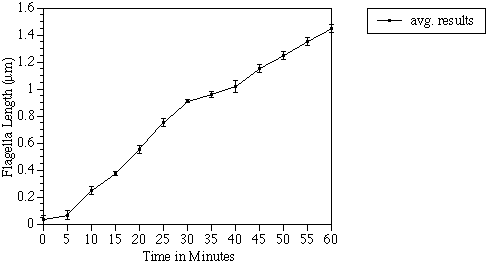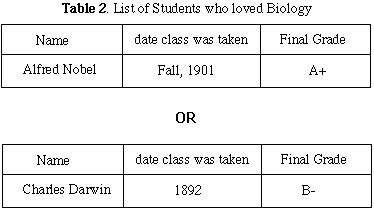
You must summarize your lab research for the semester. This will require each group to collectively submit a paper written in scientific format. This means you must have an abstract that summarizes the topic, in introduction, materials and methods, results, discussion, references, and finally figures. You may insert the figures in the text where you want them to go, or you may put them at the end of the paper.
The most important aspect is for you to clearly present the data and interpret what your data mean. Use your figures to help you but do not rely on them and simply say, "We got bands, see the figure."
I. Scientific Laboratory Report
Introduction
The "Introduction" of the report should explain why the work was done. What were the objectives of the research? How does the research help to fill a hole in our knowledge?
The Introduction should include a clear statement of the problem or question to be addressed in the experiment. It is always helpful to put this question into some context by stating why this is an important question to be answered or why you found this to be a particularly interesting question. Any background material that is particularly relevant to the question should be included in this section. In longer papers, one often includes 1-2 sentences summarizing the results and their possible importance.
Materials and Methods
The "Materials and Methods" section tells how the work was done. What procedures were followed? What research materials were used: the organism, special chemicals, instruments? In some of the labs you will be doing, many of the procedures are given in great detail in the handouts. It is not necessary to retype these verbatim, but rather summarize them, and provide details only about changes from the handout and about your individual project.
The most important feature of this section should be to include enough detail in your description of how your experiment was set up and run that anyone reading the Materials and Methods could repeat your experiment.
Results
The "Results" section explains in words what you found, the data that you generated, explained succinctly in the body of the report and presented in detail as tables or graphs. The results section should be written so that any college student could read the text to learn what you have done. For example, you might use a paragraph to explain what is seen on a particular graph; "... When the enzyme is soaked in sulfuric acid, it produced no change in absorbance...." Do not make the common mistake of saying, "We performed the experiment, see figures 1-4." That is too brief and does not convey to a novice what you have done. When stating your results in the body of the text, refer to your graphs and tables. Do not attempt to discuss the interpretation of your data-this should be done in the "Discussion" section.
Each table and figure should be numbered sequentially for easy reference in the text, and figures should have a brief description called a legend, which provides the reader enough information to know what you did to produce the data.
Discussion
The "Discussion" section typically includes your appraisal of what your research means, including its success in meeting the objectives stated in the introduction, and its significance in advancing your knowledge of the subject. This is also the place to explain discrepancies or difficulties with experiments, as well as suggestions for future work. For example, if you had initially known what you know now, how might you have changed your experiments? Most importantly, the Discussion provides an opportunity to compare your results with those of others. What previous information exists that is relevant to your research? Do your results support or supplement that information? Once again, when providing your interpretation of the data, direct the reader to specific tables and graphs to prove your point.
References
Finally, it is important to place your work in perspective with the published work of other scientists. Here are the rules if you want to supplement your discussion with results from additional sources:
The list of references should be in alphabetical order. Information should be listed in the following order:
1) For a research article citation: author(s), year, title, journal, volume and pages.
2) For a text book citation: author(s) of the book, year, book title, edition, publisher, location of publisher and the pages referenced.
3) For a technical book citation: author(s), year, chapter title, book title, editors, publisher, location of publisher and pages.
Below are three examples of citations: one for citations of research papers, one for a text book and one for a more technical book.
1) Bjorkman, O. and J. Berry (1973) High efficiency photosynthesis. Scientific American 206:1-20. [research paper example]
2) Villie, C.A., Solomon, E.P., Martin, C.E., Martin, D.W., Berg, L.R. and P.W. Davis (1989) Biology, 2 nd edition, Saunders College Publishing, Philadelphia, pp 400-450. [text book example]
3) Johnson, A. B. (1989) Chlorophyll extraction techniques. In Methods in Plant Physiology, Editors: E. Will and F. Bill, Cambridge University Press, Cambridge, pp 25-30. [technical book example]
II. Presentation of Results In Lab Reports: Figures and Tables
Data that have been collected need to be presented clearly and succinctly. As a result, two forms of presentation are most commonly used in scientific papers and reports: figures and tables. Which method to use depends somewhat on the data, but in general anything that can be displayed pictorally (e.g. as a graph or diagram) is more desirable, because the reader can immediately see the trends in the data.
In the paper itself, graphs are referred to as "Figures", and are numbered sequentially in the order of presentation (Figure 1, Figure 2, etc). Tables are also numbered sequentially. Although figures and tables are often placed directly into the middle of scientific papers, for simplicity you may include them at the end of your lab report, with one figure or table per page.
Graphs
Graphs can be made using the graphing program "Delta Graph", "Cricket Graph", or similar programs. Remember to label each axis including units of measurement and clearly identify the data you are displaying (e.g. label each line in a graph). In addition, every graph must have a short description below it to tell the reader some basic information about that data and the way it was obtained; this is known as a legend. The legend starts with the figure number, followed by a one sentence title. The text of the legend should be no more than one short paragraph and should be as brief as possible. Following is an example of a graph with legend:

Figure 1. Regeneration of Chlamydomonas flagella as a function of time. Flagella were removed from cells using the pH shock method and allowed to regrow under constant light. Each data point represents the averaged result of 30 individual cells. Error bars mark the standard error for each point.
This graph was made using the statistical program Excel and graphed with Delta Graph. Notice how the axes are labelled, and the figure is numbered and titled (bold type). The line has been identified by the small box which appears within the graph. The "text" of the legend attempts to tell how the data were obtained. Please also look at the sample scientific papers posted in the lab as other examples of legends.
Technical Hint:
To put a figure and legend together on your web page, it is easiest to first make your figure either by hand or using a computer. Then either scan your figure (ask for help) or convert it to a jpeg or gif file. You might be able to do this converstion with the software, or you can take an electronic picture of it using the shareware SnapzPro which has been installede on all of the computers in Dana 256.
Tables
Tables should be made using the same principles outlined for graphs, though the format is slightly different. Tables can be created with Wordperfect, using tabs to create the different columns. Tables are numbered, but this usually appears at the top of the table. The title can either be on a separate line directly below the table number, or can directly follow the table number:

Table 2: List of student names who loved Intro Biology in the past
(I can't include the actual data - the list is too long!)
The legend usually appears directly under the title for tables, and should contain the same information as described for graphs. The reason it is under the title is because footnotes are often used for columns, and these are placed directly below the data. Of course, all column headings should be clearly labelled as to what data are listed below them.
Lab Schedule In Context of Research Project